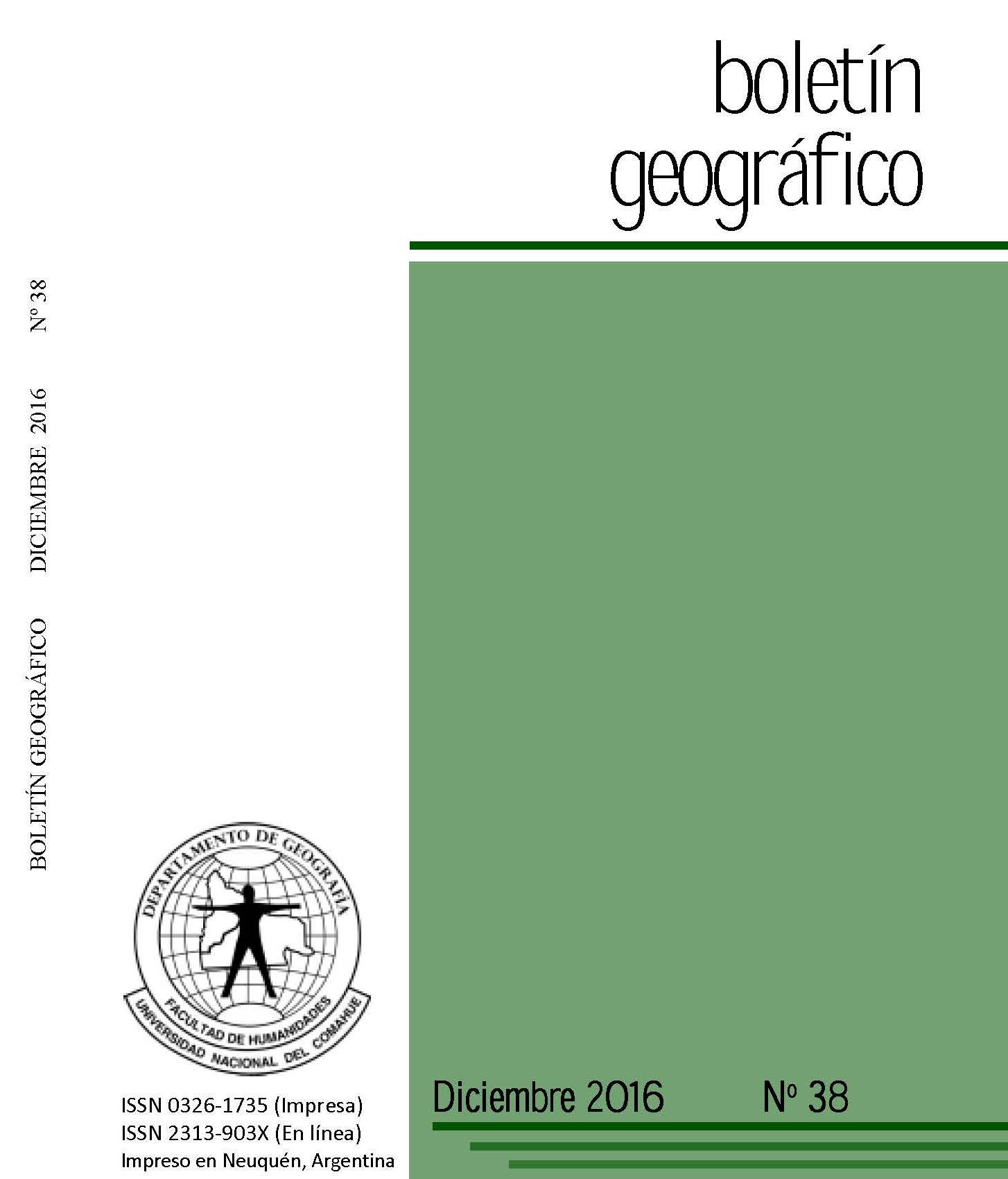The route of cacique llampilanguen (1804): geographical reconstruction of a historical path.
Keywords:
GIS, history, roads, livestock, native societiesAbstract
This is an inter-disciplinary work which links a historical problem with a scientific and technologic solution based on the contribution of geography and cartography. It emerged from an investigation on the relationship between native societies and cattle introduced by Europeans in the Pampas, and with the trade networks and moving of people and animals which took place during the period of Indian autonomy. For colonial times, there is no abundance of sources that reveal the paths followed by natives; that is what gives a special meaning to the document viewed here, which consists on the description of a journey made by Juan Llampilanguen in 1804. This cacique departed from Trupf-Trupf in the current IX Region in Chile, and arrived at the Laguna del Monte in the province of Buenos
Aires. The goal of the work is to rescue a good part of the mentioned route, up to the Guardia del Monte, adding up an overall distance of about 1,450 km. In zones where the path was not clear, the criterion used kept in mind that, given the transfer conditions at that time, the route used by a group which moved on horseback and carrying animals could only spread through places which had water availability over short distances. The methodology included the use of historical sources with ancient mapuche place names, which in part were thankfully conserved over considerable time; the cartographic base was a SRTM elevation model and Google Earth shots; and the utilized Geographical Information System (GIS) was ArcGIS 10.0, whose buffer tools were used to connect the relevant locations. In this way, the diverse tools and applications in SIG have helped to recover the trace of old communication routes in regions which, being out of colonial control, were badly known by authorities of imperial bureaucracy, and were not kept in their cartography.
Downloads
References
ABEUCCI, C. Y SARAFIAN, P. (2006). CUENCA DEL RÍO NEUQUÉN- Cuenca Nº 62. Subsecretaría de Recursos Hídricos. http://www.hidricosargentina.gov.ar/ documentos/referencias_i8/62_nueva.pdf (consultado 30/8/2015).
ALIOTO, S.L. (2011). Indios y ganado en la frontera: la ruta del río Negro (1750-1830). Prohistoria Ediciones-CEDOP UNS. Rosario. 248 pp.
BELLO MALDONADO, A. (2011). Nampülkafe. El viaje de los mapuches de la Araucanía a las pampas argentinas. Ediciones Universidad Católica de Temuco. Temuco. 207 pp.
BOCCARA, G. (1998). Guerre et ethnogenèse Mapuche dans le Chili Colonial. L´invention du soi. L´Harmattan. París. 392 pp.
CABRERA, A. L. (1976). Regiones fitogeográficas argentinas. En Enciclopedia Argentina de Agricultura y Jardinería, Tomo II. Ed. ACME. Bs. As. Argentina.
DARWIN, Ch. (1989 [1839]). Viaje de un naturalista alrededor del mundo.Ediciones Grech. Madrid.
DINERSTEIN, E.; OLSON, D.M.; GRAHAM, D.J.; WEBSTER, A.L.; PRIMM, S.A.; BOOKBINDER, M.P.; LEDEC, G. (1995). A conservation assessment of the terrestrial ecoregions of Latin America and the Caribbean. The World Bank. Washington, DC.
FUENTES F.A. (1897) Mapa de la Provincia de Cautin. En Geografía Descriptiva de la República de Chile. Imprenta y Encuadernación Barcelona. Santiago de Chile. IGM. (1983). Carta Ecorregiones de Chile. Instituto Geográfico Militar de Chile. Santiago de Chile.
JIMÉNEZ, J.F. (2002). Castas y Ponchos. Comentarios a las observaciones de Luis de La Cruz sobre el comercio de ganado entre la Cordillera y Mamil Mapu (1806). En: Aguerre, A. M. & Tapia, A.H. (comps.), Entre médanos y caldenes de la pampa seca. Arqueología, Historia, Lengua y topónimos. (pp. 201-230). Facultad de Filosofía y Letras, Universidad de Buenos Aires. Buenos Aires.
JIMÉNEZ, J.F. (2006). Relaciones inter-étnicas en la frontera meridional del virreinato del Río de la Plata (1770-1798): respuestas bélicas de los nativos frente a las reformas militares borbónicas. Tesis de doctorado. Departamento de Humanidades, Universidad Nacional del Sur. Bahía Blanca.
JIMÉNEZ, J.F. y VILLAR, D. (2004). Intercambios de castas y textiles entre los Indígenas de las Pampas y Araucanía (Río de la Plata y Chile, 1770-1806). Estudios Trasandinos. Revista de la Asociación Chileno-Argentina de Estudios Históricos e Integración Cultural, 10-11, 179-210.
JIMÉNEZ, J.F. y ALIOTO, S.L. (2016). Recorredores de mundos: viajeros nativos en las pampas y Araucanía (siglos XVIII y XIX). Revista Colombiana de Antropología, 52, 1, en prensa.
LEÓN SOLÍS, L. (1991). Maloqueros y conchavadores en Araucanía y las pampas. LOM Ediciones. Santiago de Chile.
MANDRINI, R.J. y ORTELLI, S. (2002). Los “araucanos” en las pampas. En BOCCARA, G. (ed.) Colonización, resistencia y mestizaje en las Américas (siglos XVI -XX) (pp. 237-257). Ediciones Abya-Yala/Instituto Francés de Estudios Andinos. Quito.
MELO, W.D.; JIMÉNEZ, J.F.; ALIOTO, S.L. (2014). El SIG como herramienta de recuperación de datos históricos: la ruta de Llampilanguen (1804). En Uboldi, J. y otros (comps.), Geotecnologías del Sur Argentino. Casos de estudio (pp. 63-72).Departamento de Geografía-Universidad Nacional del Sur. Bahía Blanca.
MELO, W.D.; SCHILLIZZI, R.; PERILLO, G.M.E. Y PICCOLO, M.C. (2003). Influencia del área continental pampeana sobre el origen y la morfología del estuario de Bahía Blanca. Revista de la Asociación Argentina de Sedimentología 10, 65-72.
MEYER, J. (1853). Die Republiken Chili, La Plata und Uruguay, 1853. (with) Sudl.Theil von Patagonia. H.S(chleifmann sculp). Stahlstich, Druck u. Verlag des Bibliographischen Instituts in Hildburghausen (1860). Atlas.
NAVARRO FLORIA, P. (1994). Ciencia y política en la región Nordpatagónica: el ciclo fundador (1779-1806). Departamento de Humanidades/Facultad de Educación y Humanidades, Universidad de la Frontera. Temuco. 136 pp.
O'HIGGINS, T. (1943 [1796-1797]). Diario de viaje del capitán D. Thomas O'Higgins de orden del virrey de Lima, el marqués de Osorno. 1796-1797. Revista Chilena de Historia y Geografía 103, 30-82.
PALERMO, M.A. (1991). La compleja integración hispano-indígena del sur argentino-chileno durante el período colonial. América Indígena LI, 1, 153-192.
PINTO RODRÍGUEZ, J. (1996). Redes indígenas y redes capitalistas. La Araucanía y las pampas en el siglo XIX. En Bonilla, H. y Guerrero, A. (eds.). Los pueblos campesinos de las Américas. Etnicidad, Cultura e Historias en el siglo XIX (pp.137-156). Bucaramanga.
ROJAS LAGARDE, J.L. (2004). Malones y comercio de ganado con Chile. Siglo XIX. El Elefante Blanco. Buenos Aires. 277 pp.
PAZ SOLDAN M. F. (1888). Mapa general de la República Argentina. Felix Lajouane Editor. Buenos Aires.
SAPOZNIKOW, A.; REEVES, C.; DEGORGUE, G.; SESSA, G.; DE LA RETA, M. 2008. Flora de la Estepa. Consolidación e Implementación del Plan de Manejo Integrado de la Zona Costera Patagónica para la Conservación de la Biodiversidad ARG/02/G31. Fundación Patagonia Natural. Puerto Madryn.
SIAN (1997). Mapa de Ecoregiones. Sistema de Información Ambiental Nacional.Secretaría de Ambiente y Desarrollo Sustentable. Buenos Aires.
SMITH, H. (2004). Care & Management of Horses: A Practical Guide for the Horse Owner. Eclipse Press. Lexington.
VIGNATI, M.A. (1973). Un diario inédito de Pablo Zizur. Revista del Archivo General de la Nación, 3, 65-116.
VILLAR, D.; JIMÉNEZ J.F. (2003). La tempestad de la guerra: Conflictos indígenas y circuitos de intercambio. Elementos para una periodización (Araucanía y las Pampas, 1780-1840). En MANDRINI, R.J. y PAZ, C.D. (comps.), Las fronteras hispanocriollas del mundo indígena latinoamericano en los siglos XVIII-XIX. Un estudio comparativo (pp. 123-171). IEHS, Universidad Nacional del Centro de la Provincia de Buenos Aires-CEHIR, Universidad Nacional del Comahue–Departamento de Humanidades, Universidad Nacional del Sur. Tandil.
ZEBALLOS, E. (1879). Mapa Descripción Amena de la República Argentina. En Viaje al país de los Araucanos. J. Peuser. Buenos Aires.
Downloads
Published
How to Cite
Issue
Section
License
Copyright (c) 2016 Boletin GeográficoTransfer of rights and data processing
The acceptance of an article for publication in the Journal Geographic Bulletin implies the cession of the rights of printing and reproduction, by any means and means, of the author in favor of the Department of Geography of the National University of Comahue, which will not reject any request reasonable for the authors to obtain permission to reproduce their contributions. The total or partial reproduction of the works published in the Geographic Bulletin must be done citing the origin, otherwise, the copyright is violated.
Likewise, it is understood that the concepts and opinions expressed in each work are the sole responsibility of the author, without being responsible or in solidarity, necessarily, neither the editorial staff nor the editorial staff.
It is the responsibility of the authors to be able to provide interested readers with copies of the raw data, procedure manuals, scores and, in general, relevant experimental material.
Likewise, the Management of the journal guarantees the appropriate treatment of personal data
COPYRIGHT TRANSFER FORM














 Journal of the
Journal of the 